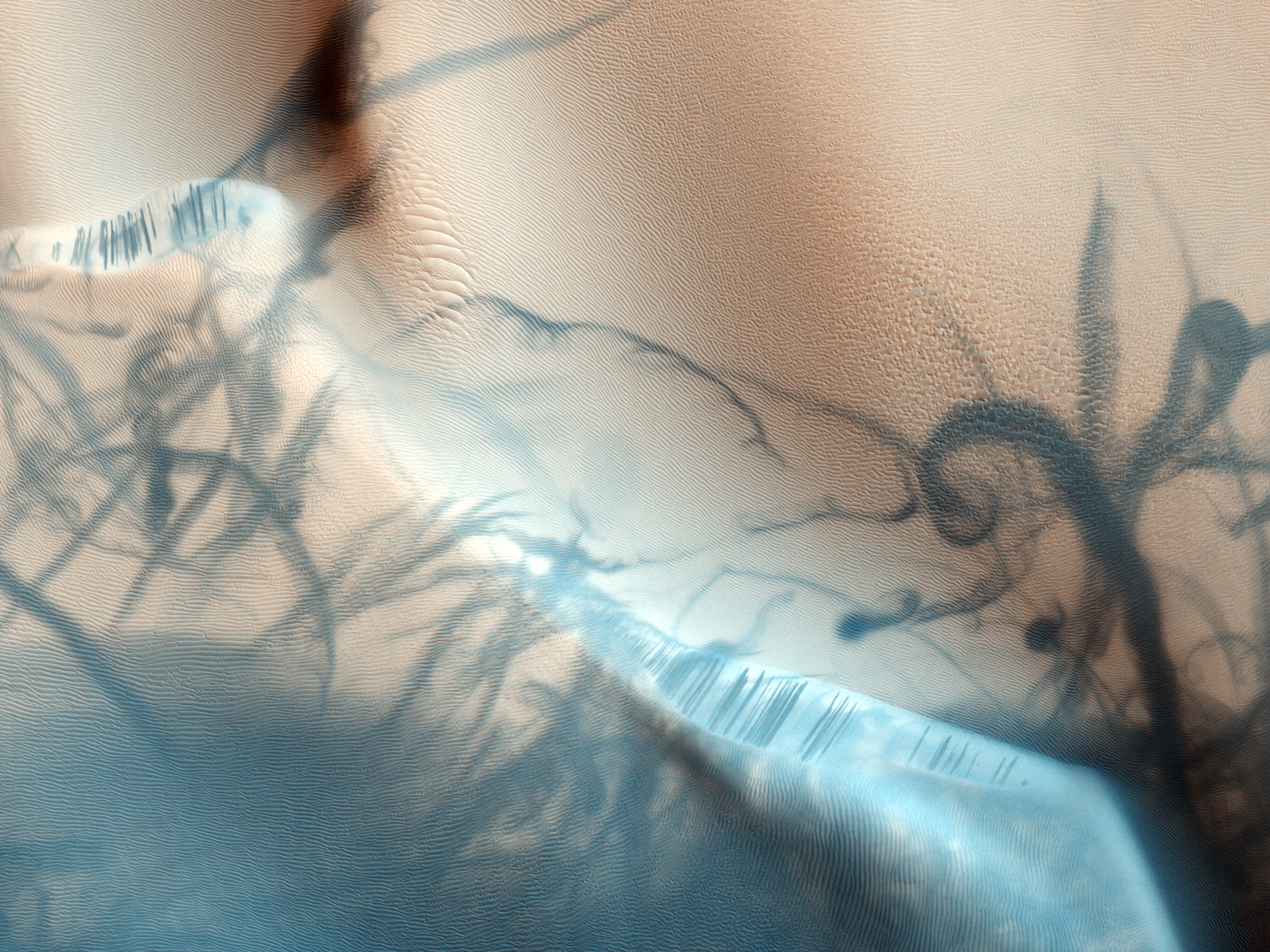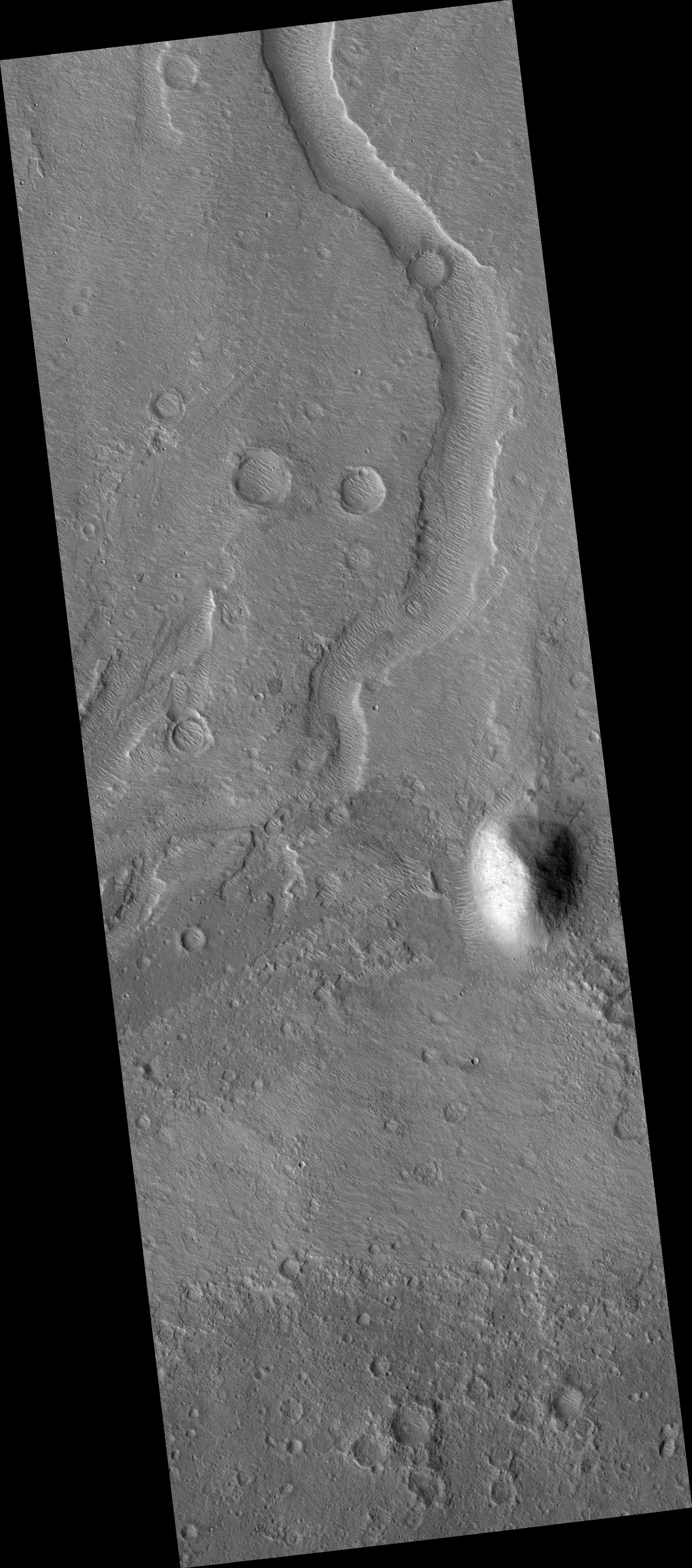|
Vallis (planetary Geology)
''Vallis'' or ''valles'' (plural ''valles'' ) is the Latin word for ''valley''. It is used in planetary geology to name landform features on other planets. Scientists used ''vallis'' for old river valleys they discovered when they sent the first probes to Mars. The Viking Orbiters caused a revolution in our ideas about water on Mars; finding huge river valleys in many areas. Space craft cameras showed that floods of water broke through dams, carved deep valleys, eroded grooves into bedrock, and traveled thousands of kilometers. Some valles on Mars ( Mangala Vallis, Athabasca Vallis, Granicus Vallis, and Tinjar Valles) clearly begin at graben. On the other hand, some of the large outflow channels begin in rubble-filled low areas, called chaos or chaotic terrain. It has been suggested that massive amounts of water were trapped under pressure beneath a thick cryosphere (layer of frozen ground), then the water was suddenly released, perhaps when the cryosphere was broken by a fault ... [...More Info...] [...Related Items...] OR: [Wikipedia] [Google] [Baidu] |
Latin
Latin (, or , ) is a classical language belonging to the Italic branch of the Indo-European languages. Latin was originally a dialect spoken in the lower Tiber area (then known as Latium) around present-day Rome, but through the power of the Roman Republic it became the dominant language in the Italian region and subsequently throughout the Roman Empire. Even after the fall of Western Rome, Latin remained the common language of international communication, science, scholarship and academia in Europe until well into the 18th century, when other regional vernaculars (including its own descendants, the Romance languages) supplanted it in common academic and political usage, and it eventually became a dead language in the modern linguistic definition. Latin is a highly inflected language, with three distinct genders (masculine, feminine, and neuter), six or seven noun cases (nominative, accusative, genitive, dative, ablative, and vocative), five declensions, four verb conjug ... [...More Info...] [...Related Items...] OR: [Wikipedia] [Google] [Baidu] |
Echus Chasma
Echus Chasma is a chasma in the Lunae Planum high plateau north of the Valles Marineris canyon system of Mars. It is in the Coprates quadrangle.ESA (2008-07-14). Echus Chasma. Retrieved on 2008-07-15 from http://www.esa.int/esaSC/SEM4CATHKHF_index_0.html. Clay has been found within it, meaning that water once sat there for a time. It may have been one of the many lakes that have been advanced for the Martian past. Research from 2010 suggests that Mars had lakes along parts of the equator, which is where Echus Chasma lies. Although earlier research had showed that Mars had a warm and wet early history that has long since dried up, these lakes existed in the Hesperian Epoch, a much later period. Using detailed images from NASA's Mars Reconnaissance Orbiter, the researchers speculate that there may have been increased volcanic activity, meteorite impacts or shifts in Mars' orbit during this period to warm Mars' atmosphere enough to melt the abundant ice present in the ground. Volc ... [...More Info...] [...Related Items...] OR: [Wikipedia] [Google] [Baidu] |
Buttes
__NOTOC__ In geomorphology, a butte () is an isolated hill with steep, often vertical sides and a small, relatively flat top; buttes are smaller landforms than mesas, plateaus, and tablelands. The word ''butte'' comes from a French word meaning knoll (but of any size); its use is prevalent in the Western United States, including the southwest where ''mesa'' (Spanish for "table") is used for the larger landform. Due to their distinctive shapes, buttes are frequently landmarks in plains and mountainous areas. To differentiate the two landforms, geographers use the rule of thumb that a mesa has a top that is wider than its height, while a butte has a top that is narrower than its height. Formation Buttes form by weathering and erosion when hard caprock overlies a layer of less resistant rock that is eventually worn away. The harder rock on top of the butte resists erosion. The caprock provides protection for the less resistant rock below from wind abrasion which leaves it stan ... [...More Info...] [...Related Items...] OR: [Wikipedia] [Google] [Baidu] |
Auqakuh Vallis
Auqakuh Vallis is an ancient river valley in the Syrtis Major quadrangle on Mars, located at 30.4° north latitude and 299.9° west longitude. It is 312 km long, and is named for the word for 'Mars' in Quechua (Inca). Buttes Many places on Mars have buttes that are similar to buttes on Earth, such as the famous ones in Monument Valley, Utah Utah ( , ) is a state in the Mountain West subregion of the Western United States. Utah is a landlocked U.S. state bordered to its east by Colorado, to its northeast by Wyoming, to its north by Idaho, to its south by Arizona, and to it .... Buttes are formed when most of a layer(s) of rocks are removed from an area. Buttes usually have a hard, erosion-resistant cap rock on the top. The cap rock causes the top of a butte to be flat. An example of a butte in the Syrtis Major quadrangle is shown in a picture on this page. References Valleys and canyons on Mars Syrtis Major quadrangle {{Mars-stub ... [...More Info...] [...Related Items...] OR: [Wikipedia] [Google] [Baidu] |
Nanedi Valles
The Nanedi Valles are a set of channels in a large valley in the Lunae Palus quadrangle of Mars, located at 4.9° N and 49.0° W. They are 508 km long and were named for the word for "planet" in Sesotho Sotho () or Sesotho () or Southern Sotho is a Southern Bantu language of the Sotho–Tswana ("S.30") group, spoken primarily by the Basotho in Lesotho, where it is the national and official language; South Africa (particularly the Free ..., the national language of Lesotho, Africa. The Nanedi Valles are located between Shalbatana Vallis and the upper Maja Valles. They are 4 km wide at their northern end. Their valley's shape is similar to that of Nirgal Vallis, being very sinuous and having only a few short branches. Unusually for Martian valleys, the individual channel structures within the wider valley floors can occasionally be seen in this system.Malin, M.C., and Carr, M.H. (1999), Groundwater formation of martian valleys, Nature, 397, 589-592 Gal ... [...More Info...] [...Related Items...] OR: [Wikipedia] [Google] [Baidu] |
HiRISE
High Resolution Imaging Science Experiment is a camera on board the '' Mars Reconnaissance Orbiter'' which has been orbiting and studying Mars since 2006. The 65 kg (143 lb), US$40 million instrument was built under the direction of the University of Arizona's Lunar and Planetary Laboratory by Ball Aerospace & Technologies Corp. It consists of a 0.5m (19.7 in) aperture reflecting telescope, the largest so far of any deep space mission, which allows it to take pictures of Mars with resolutions of 0.3m/pixel (1ft/pixel), resolving objects below a meter across. HiRISE has imaged Mars exploration rovers on the surface, including the ''Opportunity'' rover and the ongoing ''Curiosity'' mission. History In the late 1980s, of Ball Aerospace & Technologies began planning the kind of high-resolution imaging needed to support sample return and surface exploration of Mars. In early 2001 he teamed up with Alfred McEwen of the University of Arizona to propose such ... [...More Info...] [...Related Items...] OR: [Wikipedia] [Google] [Baidu] |
Hypanis Vallis
The Hypanis Valles are a set of channels in a 270 km valley in Xanthe Terra on Mars at 11° N, 314° E, in the Lunae Palus quadrangle. They appear to have been carved by long-lived flowing water, and a significant deposit (interpreted by some to be a river delta) exists at their outlet into the lowlands. [...More Info...] [...Related Items...] OR: [Wikipedia] [Google] [Baidu] |
Maja Valles
The Maja Valles are a large system of ancient outflow channels in the Lunae Palus quadrangle on Mars. Their location is 12.6° north latitude and 58.3° west longitude. The name is a Nepali word for "Mars". The Maja Valles begin at Juventae Chasma. Parts of the system have been partially buried by thin volcanic debris. The channels end at Chryse Planitia. Huge outflow channels were found in many areas by the Viking Orbiters. They showed that floods of water broke through dams, carved deep valleys, eroded grooves into bedrock, and traveled thousands of kilometers. The Maja Valles show evidence of lava flows in the northern section. Studies with HiRISE and CTX images suggest that the lava flows did not reach the turbulence necessary to erode large channels. So, the Maja Valles are believed to be have formed through water erosion.Keske, A., P. Christensen. 2017. MAJA VALLES: A MULTI-SOURCE FLUVIO-VOLCANIC OUTFLOW CHANNEL SYSTEM. Lunar and Planetary Science XLVIII (2017). 2985pdf. ... [...More Info...] [...Related Items...] OR: [Wikipedia] [Google] [Baidu] |
Maumee Valles
The Maumee Valles are a set of channels in an ancient river valley in the Lunae Palus quadrangle of Mars, located at 19.7° N and 53.2° W. They are 350 km long and were named after a North American river in Indiana and Ohio. Together with other ancient river valleys, they have provided strong evidence for a great deal of running water on the surface of Mars.Moore, P. et al. 1990. The Atlas of the Solar System. Mitchell Beazley Publishers NY, NY. Image:Kasei Valles topolabled.JPG, Area around the Northern Kasei Valles, showing relationships among Bahram Vallis and the Kasei Valles, Vedra Valles, Maumee Valles, and Maja Valles. Map location is in Lunae Palus quadrangle and includes parts of Lunae Planum and Chryse Planitia. Vallesmaumeevedrabox.jpg, Map showing relative positions of several channel systems in Lunae Palus quadrangle, including the Vedra Valles, Maumee Valles, and Maja Valles. Box indicates where these valleys can be found. Colors show elevation. See also ... [...More Info...] [...Related Items...] OR: [Wikipedia] [Google] [Baidu] |
Vedra Valles
The Vedra Valles are a set of channels in an ancient river valley in the Lunae Palus quadrangle of Mars, located at 19.4° N and 55.6° W. They are 115 km long and were named after an ancient river in Great Britain. Together with other ancient river valleys, they have provided strong evidence for a great deal of running water on the surface of Mars.Moore, P. et al. 1990. The Atlas of the Solar System. Mitchell Beazley Publishers NY, NY. Image:Kasei Valles topolabled.JPG, Area around the Northern Kasei Valles, showing relationships among Bahram Vallis and the Kasei Valles, Vedra Valles, Maumee Valles, and Maja Valles. Map location is in Lunae Palus quadrangle and includes parts of Lunae Planum and Chryse Planitia. Vallesmaumeevedrabox.jpg, Map showing relative positions of several channel systems in the Lunae Palus quadrangle, including the Vedra Valles, Maumee Valles, and Maja Valles. Box indicates their location; colors designate elevation. See also * Geology of Mars ... [...More Info...] [...Related Items...] OR: [Wikipedia] [Google] [Baidu] |
Bahram Vallis
Bahram Vallis is an ancient river valley in the Lunae Palus quadrangle of Mars at 20.7° north latitude and 57.5° west longitude. It is about 302 km long and was named after the word for 'Mars' in Persian. Bahram Vallis is located midway between Vedra Valles and lower Kasei Valles. It is basically a single trunk valley, with scalloped walls in some places. The presence of streamlined erosional features on its floor shows that fluid was involved with its formation.Baker, V. 1982. The Channels of Mars. University of Texas Press. Austin Image:Kasei Valles topolabled.JPG, Area around Northern Kasei Valles, showing relationships among Kasei Valles, Bahram Vallis, Vedra Valles, Maumee Valles, and Maja Valles. Map location is in Lunae Palus quadrangle and includes parts of Lunae Planum and Chryse Planitia. Image:Bahram Vallis.JPG, Bahram Vallis, as seen by HiRISE. Rotational landslides (slumps) are visible at the base of north wall. File:ESP 056904 2015valley.jpg, C ... [...More Info...] [...Related Items...] OR: [Wikipedia] [Google] [Baidu] |





